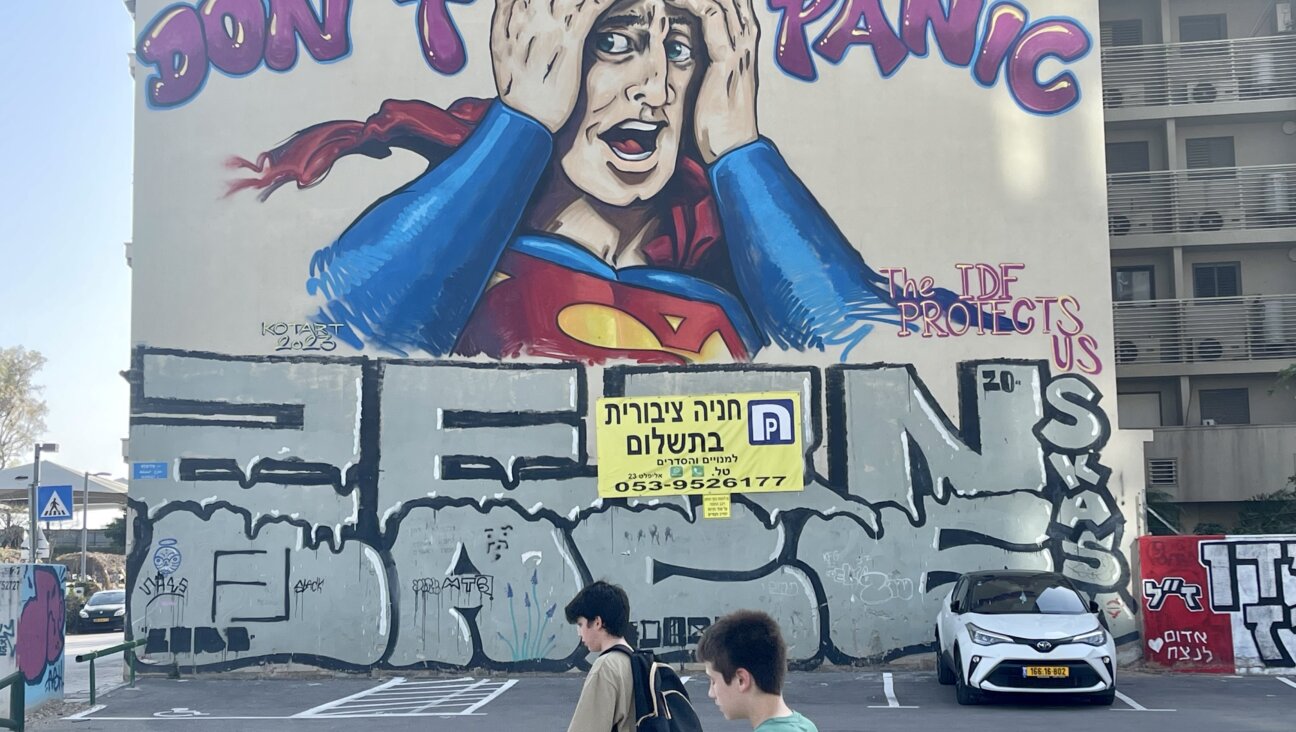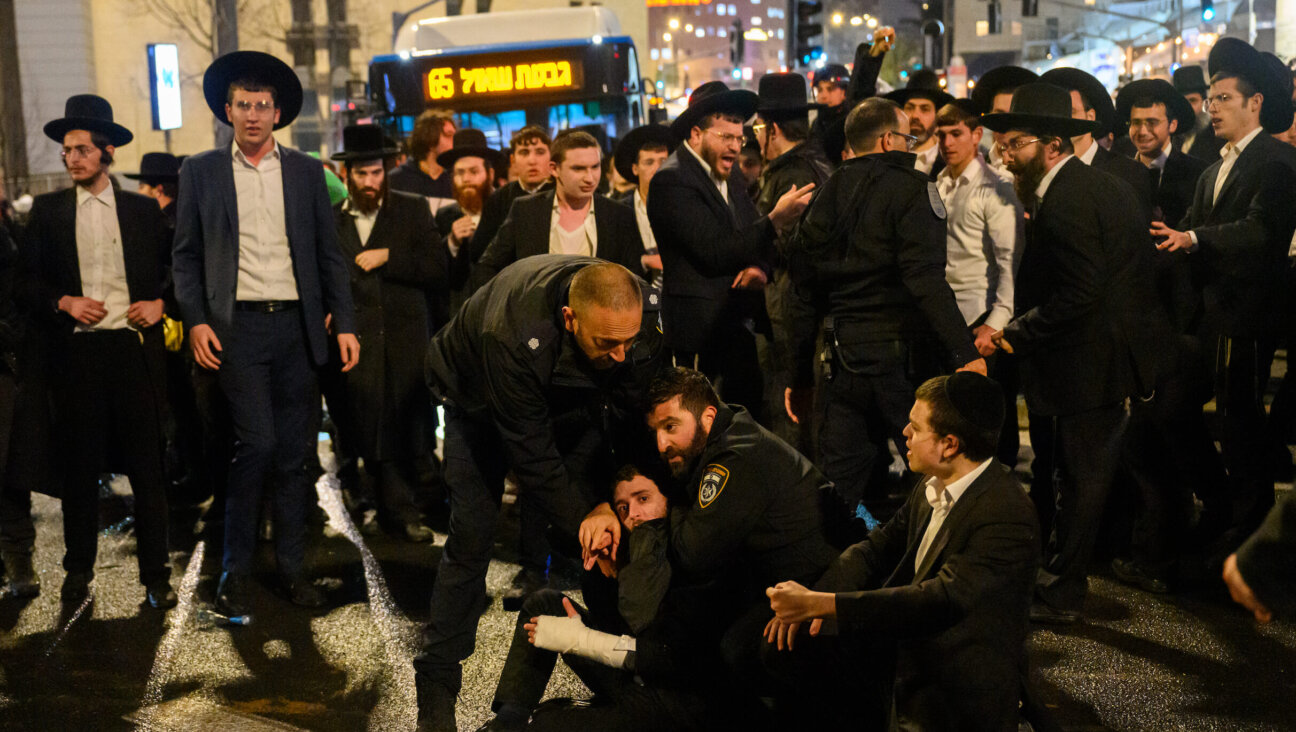Circle of Pro-Israel Writers Rises

Graphic by Angelie Zaslavsky
They’re under 30, mostly right-of-center on Israel and writing for some of the pre-eminent publications in America.

A new crop of young pro-Israel writers is on the ascent. And many of them got their start at the same place: a collection of small university journals seeded by the Shalem Center, a prominent Zionist think tank in Israel.
The rising Middle East commentators include several alumni of Columbia University’s quarterly journal, The Current. Armin Rosen, for instance, is a fellow at Atlantic Media, where he recently penned an article attacking the anti-Zionist blog Mondoweiss for having the “appearance of an anti-Semitic enterprise.” David Feith, son of George W. Bush Pentagon appointee Douglas Feith, is an assistant editor at The Wall Street Journal, where he has inveighed against the Palestinian Fatah party, Israel’s negotiating and security partner in the occupied West Bank. Jordan Hirsch is an editor at the prestigious quarterly Foreign Affairs and recently defended the legacy of right-wing Zionist ideologue Vladimir Ze’ev Jabotinsky in Tablet, an online Jewish magazine. And Bari Weiss, a senior editor at Tablet, has written for The Wall Street Journal about the Middle East and Israel.
All of these former Current editors declined to speak to the Forward.
Alumni from other Shalem-supported journals — who did speak to the Forward — have also made names for themselves writing about Israel and Judaism, though not always from a right-of-center perspective. Zvika Krieger, founder of the Yale Israel Journal, is senior vice president of The S. Daniel Abraham Center for Middle East Peace and is a correspondent for The Atlantic. And Sarah Breger, who started a journal called Kedma at the University of Pennsylvania, is the managing editor of Moment magazine.
“In a sense, these people have become young, influential voices in their communities,” said Tanya Strusberg, who ran the campus affairs program at Shalem from 2007 to 2008.
That the Shalem Center was the early nurturing ground for a cohort of rising stars of pro-Israel journalism is a happy coincidence, Strusberg said. The goal of Shalem’s student journals program was to provide an outlet for Jewish pro-Israel voices on college campuses, not necessarily to spawn a new generation of professional Israel advocates.
“I think Shalem recognized very quickly that if pro-Israel voices were coming directly from students, there was the potential to have a much greater impact,” Strusberg said. “Shalem helped to foster some very talented young people who maybe otherwise would not have found their voice initially on campus and the broader public.”
A research institute founded in 1994, Shalem began with early funding from conservative American businessman Ronald Lauder. A confidant of Benjamin Netanyahu, Israel’s current prime minister, Lauder served as Shalem’s chairman. Yoram Hazony, its founding president, was a researcher and aide to Netanyahu prior to his first stint as prime minister, from 1996 to 1999. The center has also received funding from Sheldon Adelson, another major Netanyahu supporter. It published a Zionist quarterly called Azure, edited in part by Hazony’s brother, David Hazony, who is currently a contributing editor at the Forward. Azure stopped publication in 2011.
In 2004 the Shalem Center initiated what it called the Azure Student Journals Project after a group of summer interns expressed interest in starting their own campus publications. “They saw it as a way to break out of the cheerleading mode of hasbara, which was at that time the dominant mode of Israel engagement on campuses,” said Krieger, whose Yale Israel Journal was a precursor to the Shalem-supported journals.
Shalem acquired a $100,000 grant from one of its funders, American neoconservative businessman Roger Hertog, and set up a summer training institute for future editors-in-chief. The program launched at the tail end of the second intifada, when tensions around Israel were running high on college campuses. The first interns included young activists like Weiss, one of several Columbia students who accused Joseph Massad, a professor in the Middle East and Asian Languages and Civilizations department, of anti-Israel bias. (A committee appointed by Columbia’s president to investigate Massad’s professional conduct found evidence that he was strongly critical of Israel, but no basis for allegations that he penalized or suppressed dissenting views in his classroom.)
“The students who came were seriously crème de la crème,” Strusberg said.
David Hazony, the Azure editor, trained the interns in writing, editing and publishing. The students were introduced to the “who’s who of Israel,” in Strusberg’s words: writer Yossi Klein Halevi, former Soviet refusenik Natan Sharansky, and Moshe Ya’alon, a former chief of staff of the Israel Defense Forces. All served as research fellows at Shalem. At summer’s end, the interns returned to their universities to start their journals.
Over a four-year period, Shalem alumni began publications at Columbia, the University of Toronto, Brandeis University, the University of Michigan, the University of Pennsylvania, Harvard University and others. The Yale Israel Journal, which was already in existence, served as a model for the Azure Student Journals Project.
Shalem gave these journals $2,500 per edition, which covered half the cost of the production. The students raised additional funds themselves, sometimes reaching out to campus Jewish groups to make up the difference.
David Hazony shared a Yahoo listserv for the editors and founders of the journals with the Forward. It provided a glimpse into the world of the fledgling pro-Israel publications. One message thread from 2005 dealt with transparency about the journals’ backers. Sol Adelsky, editor-in-chief of The Michigan Israel Observer, sought advice after a supportive faculty member “cringed” upon learning that Shalem was funding the journal.
“From my experience, I think it’s always best to be transparent,” Weiss, who was starting The Current at the time, wrote in one e-mail. But then she contradicted herself: “Also, from now on, better not to bring up the Shalem name. Tell them its [sic] coming from Azure — from a grant given by Hertog, who also owns half of The New Republic.” Aharon Horwitz, an adviser for the Azure Student Journals Project, replied that the editors must be “totally, totally transparent” about Shalem. “Explain that there is no, absolutely no, editorial control on the journals,” he said.
In an interview with the Forward, David Hazony also stressed that the journals were run independently, with the student founders soliciting and editing the work of their peers. “The mandate was that there needs to be an Israel focus or a Jewish focus,” he said. “We put no restrictions or limitations on the content, and we did not involve ourselves editorially.”
But Strusberg said that there was one major caveat: The student journals were barred from printing material that denied Israel’s right to exist as a Jewish state. Before the journals went to print, Strusberg reviewed every article for anti-Zionist messages. “We wanted to make sure that at all times the journals were essentially pro-Israel,” she said. “You could never publish an article which was simply condemning the state’s very existence or right to exist.” Luckily, Strusberg said, she never came across an article of that sort.
Breger, who founded Kedmah, said that she never once felt censored by Shalem in publishing her journal. “We had complete editorial control,” she said. “We decided everything what we were and weren’t going to publish.”
Perhaps because of its position on a campus where Israel was a hotly contested issue, The Current quickly became the most high profile of the student journals. Weiss and her staff published book reviews, neighborhood meanderings meant to evoke The New Yorker’s “Talk of the Town” column as well as essays about Israel and Judaism. Though decidedly Zionist in perspective, the publication did not eschew criticism of its own movement.
In The Current’s second issue, Weiss wrote that Zionism’s adherents did themselves a “huge disservice” by not touting the movement’s liberal values, such as human rights.
According to Strusberg, the journals continued to be affiliated with Shalem until 2008, when the center shed them to focus its efforts elsewhere. Several of the journals, including Kedmah and The Current, are still in operation.
In the years since The Current’s founding, several of its editors have gone on to write for major news outlets, many of them taking strikingly similar trajectories. Weiss, Feith and Hirsch all completed the Robert L. Bartley Fellowship Program at The Wall Street Journal. Weiss then served as an assistant editorial features editor there, which is Feith’s current position.
Feith also worked as an assistant editor at Foreign Affairs magazine, where Hirsch is currently a staff editor.
The Current alumni also frequently write with and for each other. Tablet, where Weiss is an editor, sometimes features the work of Hirsh and David Fine, The Current’s editor-in-chief. In 2011, Weiss and Feith shared a Wall Street Journal byline criticizing Vogue magazine for profiling Syria’s first lady, Asma al-Assad. Hirsch and Rosen shared a byline in The New Republic in 2010, when they revisited their original beat: Columbia University. The article raised questions about the university’s Center for Palestine Studies, which had just opened. In part because of its affiliation with Massad, they wrote, the center was in danger of becoming a “clique of like-minded academics whose defining commonality is hostility toward Israel.”
The most recent Current alumnus to make a media splash is Rosen. His attack on Mondoweiss in The Atlantic focused on one of its staff writers, Alex Kane, whose work recently appeared on The Daily Beast’s Israel blog, Open Zion, edited by author Peter Beinart. Rosen took this as evidence of “anti-Semitism entering mainstream discourse on Israel and Palestine.” Atlantic senior editor Robert Wright called Rosen’s article an instance of “neo-McCarthyism.”
“The term for this maneuver is ‘guilt by association,’ and it has an unfortunate history in American politics and intellectual life,” Wright wrote.
Asked what, if anything, Rosen’s article said about The Current and the Azure Student Journals Project, Strusberg said the article reflected a certain style of bulldog journalism. “I think there is a tradition that people that came out of that journal were brave, outspoken and said what they believed because it was important to them,” she said. “If a young person feels they can tackle an issue, that is a great thing.”
Contact Naomi [email protected] or on Twitter @NaomiZeveloff

















